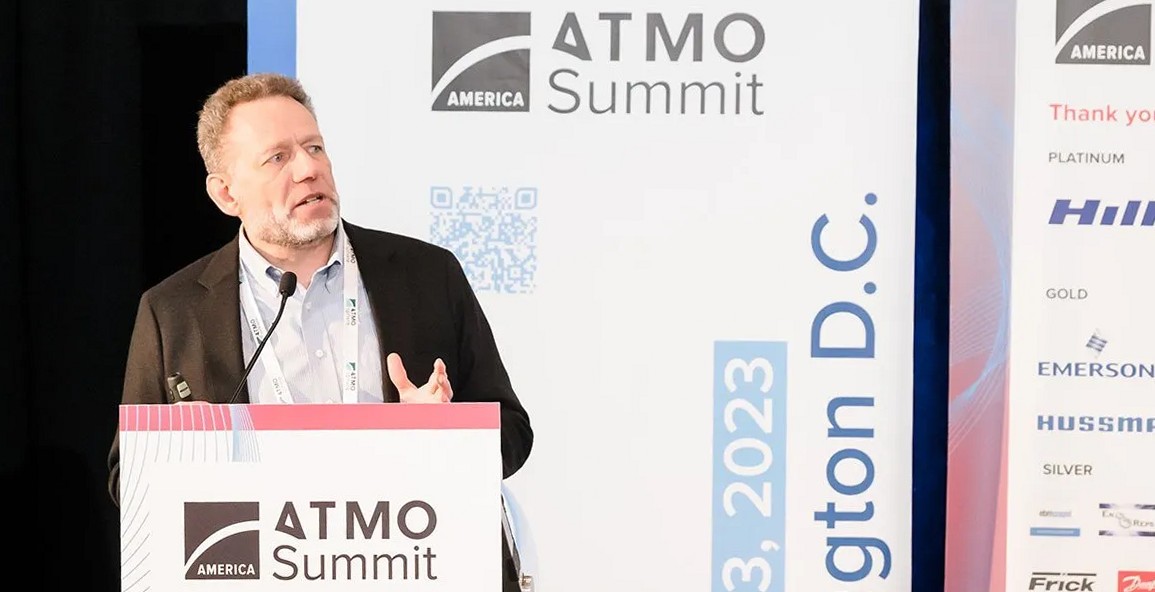Natural refrigerant heat pumps should be marketed as PFAS-free, says Seattle consultant
September 11, 2023

U.S. companies can make a difference for future generations by marketing “natural refrigerant heat pumps as PFAS [per- or polyfluorinated alkyd substances]-free,” with decarbonization and higher fossil fuel prices driving the market, said Andy Baker, Owner and Project Manager of Seattle, Washington-based YourCleanEnergy.
Baker highlighted current U.S. heat pump market trends and presented ways to increase natural refrigerant heat pump sales at the ATMOsphere America Summit 2023, hosted by ATMOsphere, publisher of R744.com, held June 12–13 in Washington, D.C.
Last year, only 10% of the 4 million heat pumps sold in the U.S. used a natural refrigerant, according to Baker. “Chemical companies are selling synthetic HFC and HFO refrigerants as ‘good for the planet’ and ‘eco-friendly,” Baker said. However, their associated high GWPs and the deposition of PFAS (per- and polyfluoroalkyl substances, known as “forever chemicals”), especially atmospheric byproduct TFA (trifluoroacetic acid) in surface water, are proving to be harmful, he added.
Research and testing of PFAS deposits in Europe, Canada and the U.S. show that most synthetic HFC and HFO refrigerants are “in whole or in part PFAS,” Baker said.
Harvard scientist Heidi Pickard supported that information in a different presentation at the summit. During her master’s degree work at Memorial University in Newfoundland, Canada, she found an increase of short-chain PFAS, including TFA, in Canadian Arctic ice cores since the 1990 Montreal Protocol, suggesting that replacing CFCs with HCFCs, HFCs and finally HFOs contribute to the accumulation of TFA. In the atmosphere, HFC-134a partially changes to TFA, and HFO-1234yf completely changes to TFA.
“We have [synthetic] refrigerants, leaking into the atmosphere, converting into TFA and ending up in surface water,” Baker said. However, unlike long-chained PFAS, TFA cannot be removed from drinking water using reverse osmosis or activated carbon.
“Once toxicity thresholds start to climb, this becomes a serious issue – a personal and intimate issue,” Baker said, explaining that the U.S. Environmental Protection Agency (EPA) has not classified TFA as PFAS even though an international group, the Organization for Economic Cooperation and Development (OECD) puts TFAs in the PFAS chemical family.
To better market natural refrigerants, Baker suggested “taking control of the frame” and putting synthetic refrigerant manufacturers on the defensive by simply saying that “natural refrigerants are PFAS-free”.
And to increase natural refrigeration heat pump sales in the U.S., Baker advocated educating end users to make better choices for their long-term finances and the environment. He explained that in 2021 U.S. heat pump sales were less than those in China and Japan and more than 30% less than those in Europe.
“When properly designed, CO2 (R744) and other natural refrigeration heat pumps are far more efficient” than synthetic ones with a roughly three-year payback,” Baker said. “We need to help U.S. clients move beyond their fixation with the first cost by looking at lifecycle costs, including refrigerant replacement from leaking synthetic systems and the potential for PFAS liability.”
In addition, U.S. industry needs to adjust its time frame in relation to GWP, said Baker. The standard 100-year scale coming out of the Montreal Protocol “is way too long.” Using a 20-year GWP timeframe doubles or triples the GWP of many synthetic refrigerants.
Propane potential
“Outside of the industrial market – where ammonia (R717) is doing well – the biggest growth we see in the U.S. for CO2 and propane (R290) is in air source heat pumps,” said Baker.
Propane has only one major obstruction and, as such, “has the greatest potential for quick growth,” he said, especially since it is about 30% more efficient than R410A. Existing U.S. regulation permits only 114g (4oz) propane in fixed or non-fixed units.
“The HVAC&R industry would like to see propane charge limits raised to at least 500g [1.1lbs] to get some heat capacity,” Baker said. He noted that the American Society of Heating, Refrigerating and Air-Conditioning Engineers (ASHRAE) and the International Institute of Ammonia Refrigeration (IIAR) are petitioning Underwriters Laboratories (UL), which writes safety standards used in building codes, to raise propane charge limits.
In another presentation at the summit, Christina Starr, Senior Manager of Climate Campaigns at the Environmental Investigation Agency (EIA) urged the industry to get involved to help the U.S. “harmonize” with the May 2022 International Electrotechnical Committee (IEC) standard, which raised the global charge allowance to 988g (2.18lbs) of propane in a (fixed) split AC unit and 304g (10.7oz) in a non-fixed one.
The residential and commercial market for CO2 heat pumps will soon open for domestic hot water, Baker said, with several companies, including Mayekawa, Lync By Watts, Mitsubishi-Trane and Transom, showcasing units at the 2023 AHR EXPO.
At present, several systemic barriers hinder the growth of rack-mounted CO2 heat pumps for space or district heating, Baker said. Among those barriers are higher initial upfront costs and a lack of understanding among engineers and decarbonization groups.
One issue is that guidelines used by Leadership for Energy and Environmental Design (LEED) and the Living Building Challenge (LBC) for designing low-carbon buildings do not “red list” PFAS, HFC and HFO refrigerants as toxins, nor do they recognize TFA as a building by-product, Baker said. “There is a conflict there that we hope to resolve by meeting with them.”
As an engineer with experience in evaluating and designing commercial CO2 heat pump systems, Baker partnered with ATMOsphere this past year to identify opportunities and obstructions in the U.S. market. He seeks to build a coalition to grow the North American natural refrigerant heat pump market.


